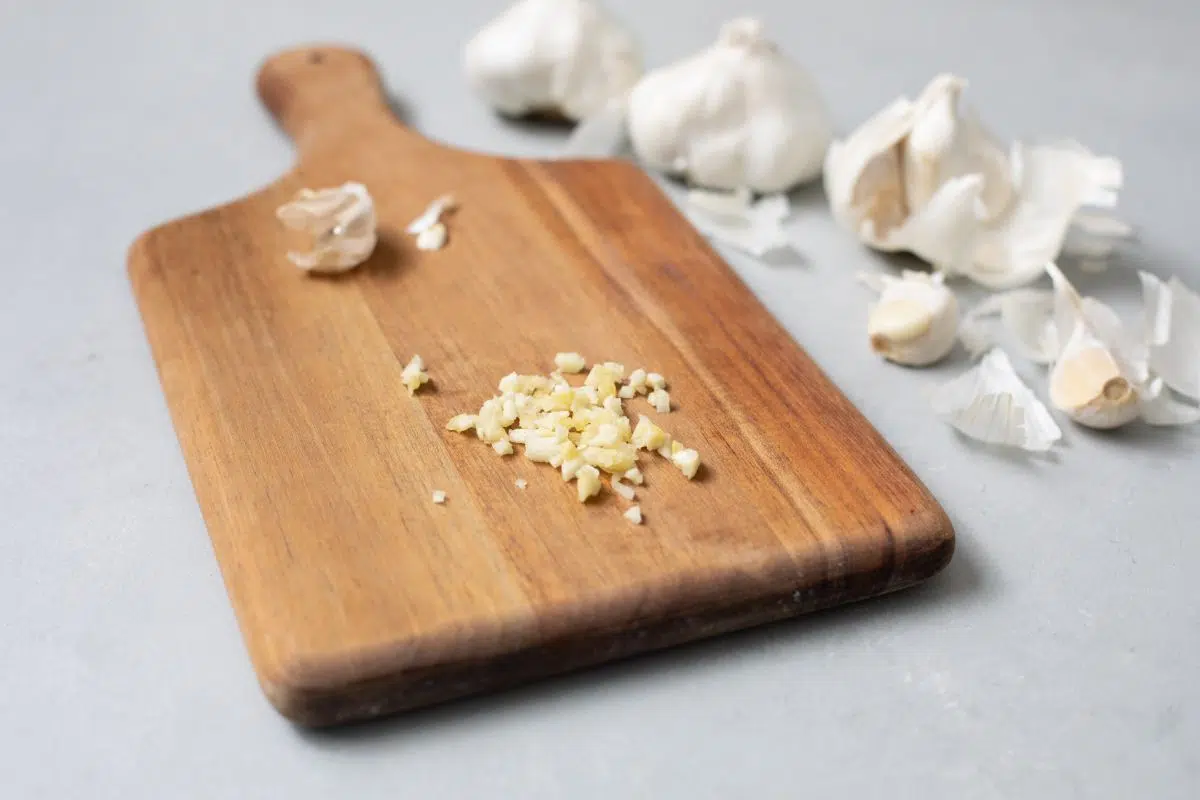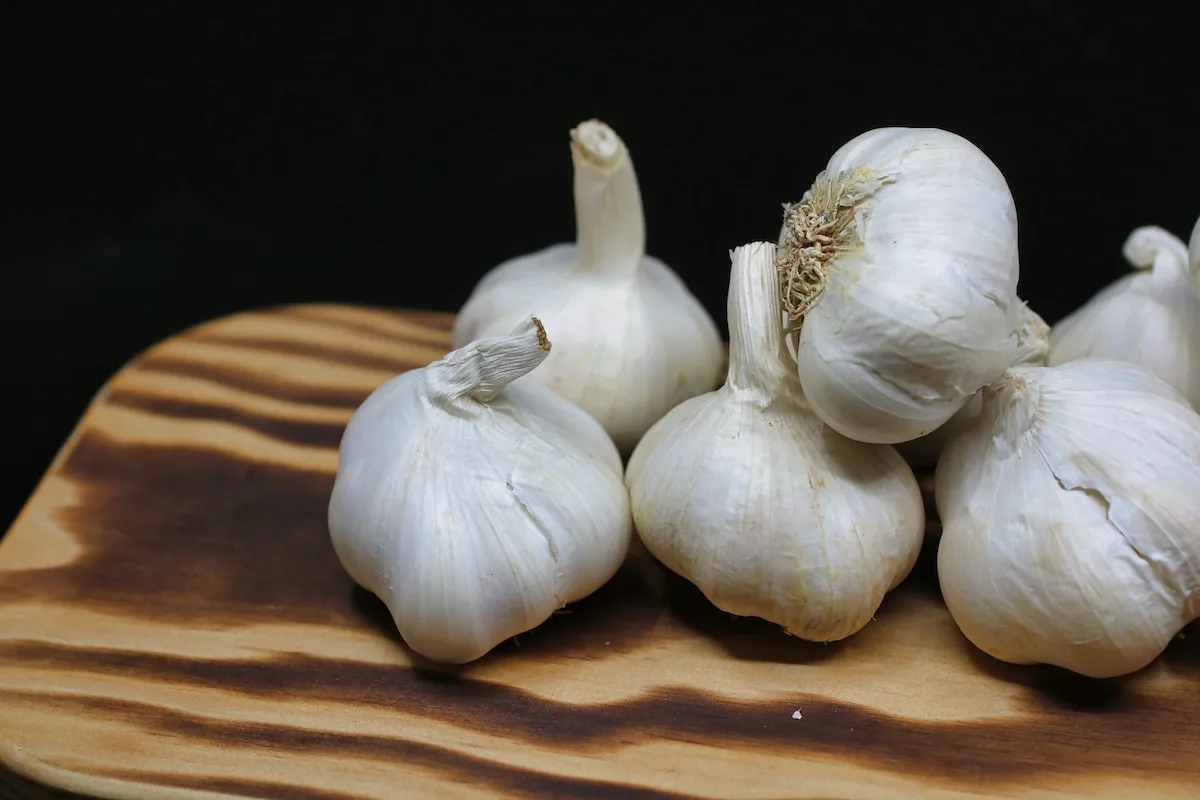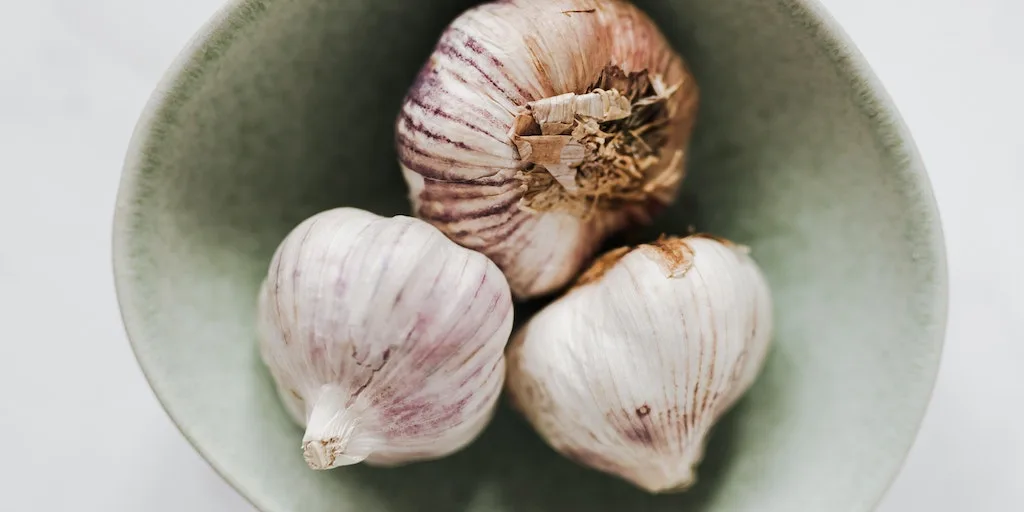Minced garlic is a useful ingredient that’s used in lots of savory recipes, like pasta sauce, stir fries, and baked meat.
As minced garlic is such an important element in the kitchen, it’s a good idea for home cooks to learn how to mince it.

Everyone has their preferred method of mincing garlic.
For instance, a lot of expert chefs dismiss the garlic press tool and prefer to hand-mince it with a knife.
Beginner home cooks, in contrast, may find that the garlic press helps them save time when in the kitchen.
There are lots of different ways to mince garlic which all have their advantages and disadvantages. Each method also affects how the garlic looks and tastes.
You’ll learn some of these methods in this post, including why it’s so important to cut garlic in the first place.
Why Is It Important To Cut Garlic?
Most of us are familiar with garlic’s pungent aroma and flavor, but you may not know that adding a single, uncut clove to dishes won’t give it a very strong garlic flavor.
The clove needs to be cut, minced, or smashed to deliver its tasty properties.
Cutting garlic releases its enzymes and acids that create a powerful fragrance and intense, sharp flavor.
The more the garlic is treated, the more powerful the garlic flavor, particularly with processes that free a lot of the garlic’s juices – like mincing!
Methods Of Mincing Garlic
There are a few methods of mincing garlic for various skill levels.
As you mince your garlic, don’t throw away the garlic skins.
Keep them on the side to make a broth or stock more flavorful.
Mincing With A Knife
To mince garlic with a knife, securely hold a garlic clove on a chopping board, positioning your knuckles forward to protect your fingers from the sharp blade.
Use the sharp knife to slice the clove into multiple thin parts.
Heap the slices together and cut through them once more to make thinner slices, then slice through them again to dice them into very small cubes.
Taste And Consistency
Small diced pieces that are roughly equal in size.
The mince will have a dry finish and a refreshing flavor, but it will be less pungent compared to other processes that release more of the garlic’s juices.
Advantages
Knife-minced garlic creates uniform pieces that cook at an equal rate, so your dish won’t be affected by any bigger, underdone pieces.
Disadvantages
Knife mincing takes more time compared to other methods, which can be a disadvantage in dishes that need lots of garlic.
This method can also be difficult for beginner cooks that haven’t practiced knife skills.
Knife Smashing
To smash your garlic, carefully lay the flat edge of your knife on top of your clove.
Next, either press down or smack it with your hand until the garlic has flattened.
Move your knife’s blade backward and forward through the smashed clove until it’s shredded into little pieces.
Taste And Consistency
This rougher method frees more of the garlic’s juices, leading to a more powerful and sharper flavor.
Advantages
Quicker method compared to knife mincing as you won’t need to cut the clove into slices first.

Disadvantages
Messier method, as it naturally frees a lot of juices on your chopping board.
Garlic Press
To use a garlic press tool, peel your garlic clove and place it inside the press.
Some models may allow you to use unpeeled garlic.
Squeeze the press’ handle to push the garlic through its holes.
Taste And Consistency
Watery, little pieces of garlic.
Releases lots of juices for a potent, spicy, and sharp flavor.
Advantages
High-quality, well-made garlic presses are easy to operate and mince the cloves easily.
You won’t need to handle the garlic that much, so you’ll get less of its juices on your fingers.
Disadvantages
Less expensive presses leave a lot of garlic matter behind, wasting some garlic that would have been useful.
They are also harder to clean.
A garlic press is a tool that only does one job, so it may be worthwhile looking into multipurpose tools instead.
Finely Grating
Hold your Microplane grater over a bowl with one hand, then rub a peeled garlic clove over its surface. The juices and garlic matter will fall through the grater into the bowl.
Use a rubber spatula or a fork to remove leftover garlic from the grater.

Taste And Consistency
Garlic turns into a liquidy puree, leading to a very pungent, sharp, and bitter taste.
Advantages
Grating the entire garlic clove is fast and easy.
You may already have the grater tool in your kitchen, as it’s useful for grating hard cheese and citrus zest.
Disadvantages
The garlic’s bitter flavor may not be distinct in slow-cooked meals, but it may influence how quicker dishes, like uncooked sauces or stir-fries, taste.
Ribbon Grater Tool
Peel your garlic and rub the cloves over your ribbon grater’s longer, thin blades.
Keep a plate or a bowl underneath the grater to catch the falling garlic.
Taste And Consistency
Creates thin garlic flakes.
Grating frees a lot of liquid, which gives the garlic a strong flavor, without any of the harshness of finely grated garlic.
Advantages
Grates garlic at a fast rate, so you’ll be able to do it when cooking other dishes.
Disadvantages
This ribbon grater type of surface isn’t present on a lot of regular box graters, so you may need to go out of your way to buy one.
Mini Food Processor
Peel your garlic gloves and add them to your mini food processor’s bowl.
Securely fasten the lid, then pulse a few times to mince the cloves.
Taste And Consistency
Creates finer dice compared to mincing with a knife, but doesn’t form very equal pieces.
The garlic is more pungent compared to knife-minced garlic, but not as spicy or watery as a garlic press.
Advantages
This is a quick method of mincing lots of garlic cloves.
You won’t need to handle the garlic much with your fingers, and you can use the mini food processor for other purposes in the kitchen too.
Disadvantages
You’ll have to clean more of the processor’s parts compared to other methods.
Final Thoughts
Now you know some of the best ways to mince garlic!
The tools above are generally affordable.
Whether you opt for using a knife, food processor, or ribbon grater, there’ll be a method that suits your experience level in the kitchen.
The ribbon grater method will release most of the garlic’s flavor, but if you don’t want to purchase a new tool, the ‘smashing’ method will do the trick in a more rustic manner.
We hope that you find these methods of mincing garlic useful!

Ingredients
- 7 ounces garlic cloves
- 1 teaspoon vegetable oil
Instructions
- To make garlic paste, start by mincing 7 ounces of garlic cloves in a food processor or blender until finely minced. Then, add 1 teaspoon of vegetable oil and mix everything together thoroughly until the mixture forms a paste.
- Next, transfer the garlic paste into an airtight container and store it in the refrigerator. If you want to freeze your garlic paste for even longer storage, you can freeze it in an ice cube tray. Each cube can be roughly 1 teaspoon of the paste, making it easy to portion out for future use.
